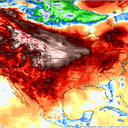Astonishing early winter heat grips U.S., Canada and shatters records

A widespread and intense heatwave is roasting large portions of the U.S. and Canada, shattering daily and monthly temperature records.
Why it matters: Winter is the fastest-warming season across the U.S., and the lingering warmth is shortening the snow season in places like Colorado and Montana, where mountain snowpack is a critical source of water during the summer months.
The big picture: On Wednesday, British Columbia saw its highest temperature ever recorded during the month of December, with a high of 72.5°F recorded in Penticton, which is 250 miles east of Vancouver. This tied the country's all-time record high for the month.
By the numbers: Temperatures across the Plains, portions of the Rockies and Central states are running as much as 35°F above average for this time of year.
- Four states have tied or broken records for the hottest temperatures seen during December: Washington, Montana, Wyoming and North Dakota, according to weather historian Maximiliano Herrera.
- In Denver, Colorado, which often picks up heavy snow at the start and end of winter, it has not yet snowed, setting a record for the latest measurable snowfall. The forecast high temperature on Thursday is in the mid-70s, about 30°F above average for this time of year.
- Records are expected to fall Thursday in Denver, Omaha, Oklahoma City and Kansas City, Missouri among other locations. According to Herrera, Hettinger, North Dakota, located just north of the South Dakota border, hit 71°F on Wednesday, setting a monthly record for the state.
- In Cheyenne, Wyo., the temperature reached 70°F on Thursday, setting a state record for the month of December. A monthly record was also set in Nebraska, according to the National Weather Service.
- The warmth, combined with powerful atmospheric river events rolling in off the Pacific Ocean has eaten away at the snowpack in the Pacific Northwest and Canadian Rockies, contributing to flooding at lower elevations.
Context: The proximate cause of the warmth is a sprawling area of high pressure, or heat dome, parked across the West, with the clockwise flow of air around it pumping mild air across the region.
- This weather feature has been deflecting storminess far to the north, and prevented colder air — record cold currently lurks in Alaska, for example — from spilling south.
- Long-term trends also favor more frequent and intense extreme heat events. This ongoing event is likely to make the already lopsided balance between warm and cold records in the U.S. for 2021 even more in favor of the warm milestones, possibly by more than a 2 to 1 margin.
- If the climate were not warming, one would expect such records to have a ratio of about one-to-one, especially over the course of a decade or more, but those figures are skewed too.
What's next: The National Weather Service's Climate Prediction Center heavily favors continued milder than average conditions across much of the Lower 48 states during the next two weeks, after a temporary cool down this weekend.
- Beyond that point, however, there may be a pattern change in the works, thanks in part to a typhoon currently spinning across the northwestern Pacific Ocean.